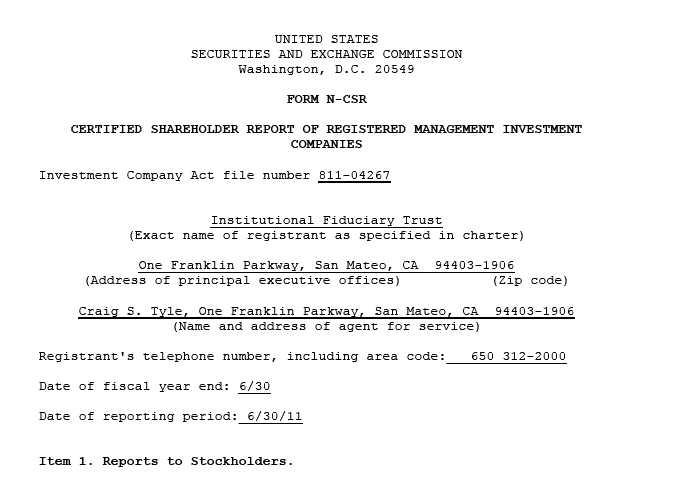
JUNE 30, 2011
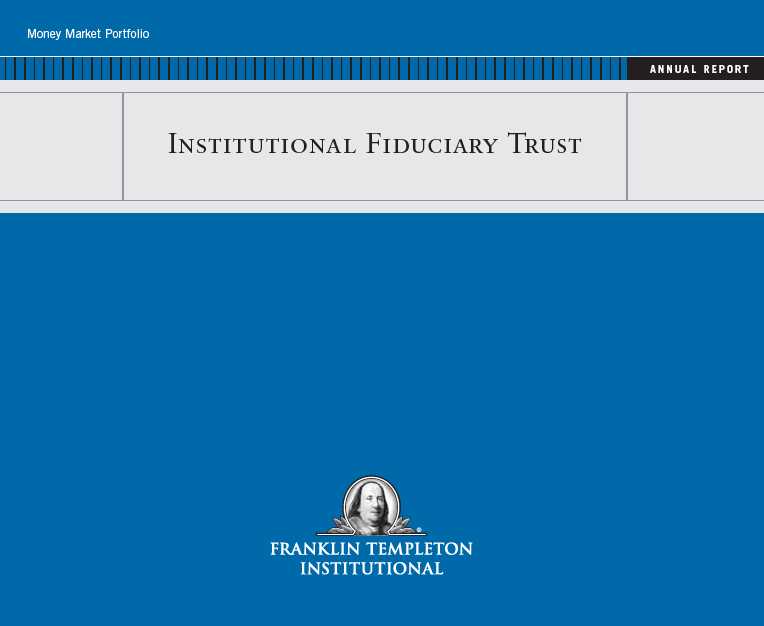

Annual Report
IFT Money Market Portfolio
Your Fund’s Goal and Main Investments: The IFT Money Market Portfolio seeks to
provide as high a level of current income as is consistent with preservation of shareholders’ capital and liquidity. The Fund invests through The Money Market Portfolio (the Portfolio) mainly in high-quality, short-term U.S. dollar denominated money market securities of domestic and foreign issuers. The Fund attempts to maintain a stable $1.00 share price.
This annual report for IFT Money Market Portfolio covers the fiscal year
Performance data represent ended June 30, 2011. past performance, which does not guarantee future results.
Investment return will fluctuate.
Performance Overview
Current performance may differ from figures shown. Please call a In an effort to promote economic growth, the Federal Reserve Board (Fed) Franklin Templeton Institutional held short-term interest rates at a historically low level during the 12-month Services representative at period under review. As a result, the Fund’s seven-day annualized yield was (800) 321-8563 for most recent unchanged at 0.00% from June 30, 2010, through June 30, 2011. month-end performance.
Economic and Market Overview
As consumer spending rose during the 12-month reporting period, the U.S.
An investment in the Fund is not economy expanded, although the pace of growth slowed. Fed policymakers insured or guaranteed by the maintained historically low interest rates while adopting a more restrained view
Federal Deposit Insurance of the economy largely because of developments in Europe and signs the U.S.
Corporation or any other govern-economic expansion lacked momentum. The Fed announced in November it ment agency or institution.
Although the Fund seeks to preserve the value of your investment at $1.00 per share, it is possible to The dollar value, number of shares or principal amount, and names of all portfolio holdings are listed in the Fund’s Statement of Investments (SOI). The SOI begins on page 7. lose money by investing in the Fund.
NOT FDIC INSURED | MAY LOSE VALUE | NO BANK GUARANTEE
Annual Report | 1
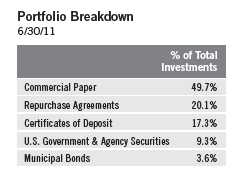
intended to buy $600 billion of longer term Treasury securities by the end of the second quarter of 2011. It sought to promote a stronger recovery and help maintain inflation levels the Fed believed were consistent with its dual mandate to foster maximum employment and price stability. Despite the Fed’s actions, the economic recovery stalled. U.S. home prices fell sharply during the fourth quarter of 2010 and the first quarter of 2011, and unemployment remained stubbornly high. After showing solid improvement during the year, manufacturing activity weakened partly because of auto supply-chain disruptions following Japan’s natural disasters.
Geopolitical instability in North Africa and the Middle East drove up oil prices for most of the period. However, investor concerns over weak economic data caused crude oil prices to drop from their 12-month high of $114 per barrel on April 29 to $95 at period-end. Storms and droughts in several states reduced crop yields, pushing up grain prices. As oil and food prices rose, the pace of inflation accelerated during the period.
Despite turmoil in North Africa and the Middle East, the multiple crises triggered by Japan’s earthquake and headwinds facing the U.S. economy, generally favorable economic improvements and positive corporate earnings reports gave investors confidence. While equity and fixed income markets performed well overall for the 12 months under review, investors reacted to reports on the Greek debt crisis by seeking the perceived safe haven of U.S. Treasuries. At period-end, the Greek government approved an austerity bill to secure a bail-out loan from international creditors, which helped relieve investor anxiety.
On August 2, 2011, the U.S. raised its debt ceiling and avoided defaulting on its debt obligations. Independent credit rating agency Standard & Poor’s (S&P) lowered the country’s long-term rating to AA+ from AAA, citing political risks and a rising debt burden.1 At the same time, however, S&P affirmed the highest short-term rating, A-1+, of the U.S. A few days later, S&P similarly lowered the long-term ratings of government-related entities Fannie Mae and Freddie Mac while affirming their A-1+ short-term ratings. Short-term debt obligations are those that generally have maturities of one year or less.
Investment Strategy
Consistent with our strategy, we invest, through the Portfolio, mainly in high-quality, short-term U.S. dollar denominated money market securities of domestic and foreign issuers, including bank obligations, commercial paper,
1. These do not indicate ratings of the Fund. STANDARD & POOR’S®, S&P® and S&P 500® are registered trademarks of Standard & Poor’s Financial Services LLC. Standard & Poor’s does not sponsor, endorse, sell or promote any S&P index-based product.
2 | Annual Report
repurchase agreements and U.S. government securities. We maintain a dollar-weighted average portfolio maturity of 60 days or less. We seek to provide shareholders with a high-quality, conservative investment vehicle; thus, we do not invest the Fund’s cash in derivatives or other relatively volatile securities that we believe involve undue risk.
Manager’s Discussion
The 12 months under review were characterized by extremely low short-term interest rates, which pressured money market yields. We continued to invest the Portfolio’s assets in high-quality money market securities. On June 30, 2011, for example, 100% of the rated securities purchased for the Portfolio carried short-term credit ratings of A-1 or P-1, or higher, by independent credit rating agency Standard & Poor’s or Moody’s Investors Service.1
We appreciate your support, welcome new shareholders and look forward to serving your investment needs in the years ahead.
The foregoing information reflects our analysis, opinions and portfolio holdings as of June 30, 2011, the end of the reporting period. The way we implement our main investment strategies and the resulting portfolio holdings may change depending on factors such as market and economic conditions. These opinions may not be relied upon as investment advice or an offer for a particular security. The information is not a complete analysis of every aspect of any market, country, industry, security or the Fund. Statements of fact are from sources considered reliable, but the investment manager makes no representation or warranty as to their completeness or accuracy. Although historical performance is no guarantee of future results, these insights may help you understand our investment management philosophy.

Annual Report | 3
Your Fund’s Expenses
As a Fund shareholder, you can incur two types of costs:
- Transaction costs, including sales charges (loads) on Fund purchases; and
- Ongoing Fund costs, including management fees, distribution and service (12b-1) fees, and other Fund expenses. All mutual funds have ongoing costs, sometimes referred to as operating expenses.
The following table shows ongoing costs of investing in the Fund and can help you understand these costs and compare them with those of other mutual funds. The table assumes a $1,000 investment held for the six months indicated.
Actual Fund Expenses
The first line (Actual) of the table provides actual account values and expenses. The “Ending Account Value” is derived from the Fund’s actual return, which includes the effect of Fund expenses.
You can estimate the expenses you paid during the period by following these steps. Of course, your account value and expenses will differ from those in this illustration:
| 1. | Divide your account value by $1,000. |
| If an account had an $8,600 value, then $8,600 ÷ $1,000 = 8.6. | |
| 2. | Multiply the result by the number under the heading “Expenses Paid During Period.” |
| If Expenses Paid During Period were $7.50, then 8.6 x $7.50 = $64.50. |
In this illustration, the estimated expenses paid this period are $64.50.
Hypothetical Example for Comparison with Other Funds
Information in the second line (Hypothetical) of the table can help you compare ongoing costs of investing in the Fund with those of other mutual funds. This information may not be used to estimate the actual ending account balance or expenses you paid during the period. The hypothetical “Ending Account Value” is based on the Fund’s actual expense ratio and an assumed 5% annual rate of return before expenses, which does not represent the Fund’s actual return. The figure under the heading “Expenses Paid During Period” shows the hypothetical expenses your account would have incurred under this scenario. You can compare this figure with the 5% hypothetical examples that appear in shareholder reports of other funds.
4 | Annual Report
Your Fund’s Expenses (continued)
Please note that expenses shown in the table are meant to highlight ongoing costs and do not reflect any transaction costs, such as sales charges. Therefore, the second line of the table is useful in comparing ongoing costs only, and will not help you compare total costs of owning different funds. In addition, if transaction costs were included, your total costs would have been higher. Please refer to the Fund prospectus for additional information on operating expenses.

*Expenses are calculated using the most recent six-month annualized expense ratio, net of voluntary expense waivers, of 0.17%, which includes the expenses incurred by the Portfolio, multiplied by the average account value over the period, multiplied by 181/365 to reflect the one-half year period.
Annual Report | 5
Institutional Fiduciary Trust
Financial Highlights
Money Market Portfolio

6 | The accompanying notes are an integral part of these financial statements. | Annual Report
| Institutional Fiduciary Trust | ||||
| Statement of Investments, June 30, 2011 | ||||
| Money Market Portfolio | Shares | Value | ||
| Mutual Funds (Cost $10,126,909,529) 100.0% | ||||
| a The Money Market Portfolio, 0.00% | 10,126,909,529 | $ | 10,126,909,529 | |
| Other Assets, less Liabilities (0.0)%† | (40,440 | ) | ||
| Net Assets 100.0% | $ | 10,126,869,089 | ||
| †Rounds to less than 0.1% of net assets. | ||||
| aThe rate shown is the annualized seven-day yield at period end. | ||||
Annual Report | The accompanying notes are an integral part of these financial statements. | 7

8 | The accompanying notes are an integral part of these financial statements. | Annual Report

Annual Report | The accompanying notes are an integral part of these financial statements. | 9
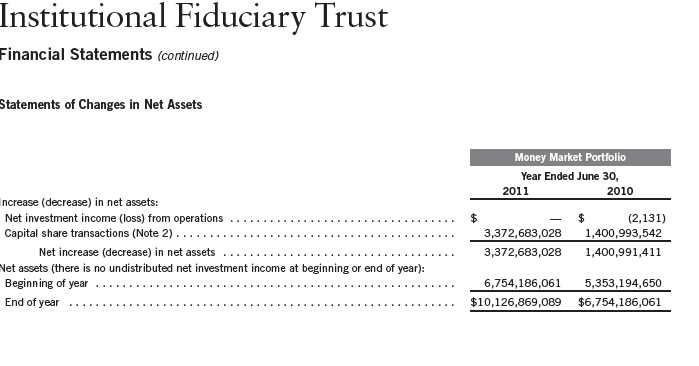
10 | The accompanying notes are an integral part of these financial statements. | Annual Report
Institutional Fiduciary Trust
Notes to Financial Statements
Money Market Portfolio
1. ORGANIZATION AND SIGNIFICANT ACCOUNTING POLICIES
Institutional Fiduciary Trust (Trust) is registered under the Investment Company Act of 1940, as amended, (1940 Act) as an open-end investment company, consisting of one fund, the Institutional Fiduciary Trust Money Market Portfolio (Fund).
The Fund invests substantially all of its assets in The Money Market Portfolio (Portfolio), which is registered under the 1940 Act as an open-end investment company. The accounting policies of the Portfolio, including the Portfolio’s security valuation policies, will directly affect the recorded value of the Fund’s investment in the Portfolio. The financial statements of the Portfolio, including the Statement of Investments, are included elsewhere in this report and should be read in conjunction with the Fund’s financial statements.
Shares of the Fund are offered to other investment companies and accounts managed by Franklin Advisers Inc. (Advisers) or its affiliates, and to other institutional investors. At June 30, 2011, Advisers, affiliates of Advisers, and investment companies and accounts managed by Advisers or its affiliates owned 10,108,391,952 shares of the Fund.
The following summarizes the Fund’s significant accounting policies.
a. Financial Instrument Valuation
The Fund holds Portfolio shares that are valued at the closing net asset value of the Portfolio. At June 30, 2011, the Fund owned 83.73% of the Portfolio.
b. Income Taxes
It is the Fund’s policy to qualify as a regulated investment company under the Internal Revenue Code. The Fund intends to distribute to shareholders substantially all of its taxable income and net realized gains to relieve it from federal income and excise taxes. As a result, no provision for U.S. federal income taxes is required. The Fund files U.S. income tax returns as well as tax returns in certain other jurisdictions. The Fund records a provision for taxes in its financial statements including penalties and interest, if any, for a tax position taken on a tax return (or expected to be taken) when it fails to meet the more likely than not (a greater than 50% probability) threshold and based on the technical merits, the tax position may not be sustained upon examination by the tax authorities. As of June 30, 2011, and for all open tax years, the Fund has determined that no provision for income tax is required in the Fund’s financial statements. Open tax years are those that remain subject to examination and are based on each tax jurisdiction statute of limitation.
Annual Report | 11
Institutional Fiduciary Trust
Notes to Financial Statements (continued)
Money Market Portfolio
| 1. | ORGANIZATION AND SIGNIFICANT ACCOUNTING POLICIES (continued) |
| c. | Security Transactions, Investment Income, Expenses and Distributions |
Security transactions are accounted for on trade date. Realized gains and losses on security transactions are determined on a specific identification basis. Income received from the Portfolio and estimated expenses are accrued daily. Dividends from net investment income are normally declared daily; these dividends may be reinvested or paid monthly to shareholders. Distributions to shareholders are determined according to income tax regulations (tax basis). Distributable earnings determined on a tax basis may differ from earnings recorded in accordance with accounting principles generally accepted in the United States of America. These differences may be permanent or temporary. Permanent differences are reclassified among capital accounts to reflect their tax character. These reclassifications have no impact on net assets or the results of operations. Temporary differences are not reclassified, as they may reverse in subsequent periods.
d. Accounting Estimates
The preparation of financial statements in accordance with accounting principles generally accepted in the United States of America requires management to make estimates and assumptions that affect the reported amounts of assets and liabilities at the date of the financial statements and the amounts of income and expenses during the reporting period. Actual results could differ from those estimates.
e. Guarantees and Indemnifications
Under the Trust’s organizational documents, its officers and trustees are indemnified by the Trust against certain liabilities arising out of the performance of their duties to the Trust. Additionally, in the normal course of business, the Trust, on behalf of the Fund, enters into contracts with service providers that contain general indemnification clauses. The Trust’s maximum exposure under these arrangements is unknown as this would involve future claims that may be made against the Trust that have not yet occurred. Currently, the Trust expects the risk of loss to be remote.
2. SHARES OF BENEFICIAL INTEREST
At June 30, 2011, there were an unlimited number of shares authorized (without par value).
Transactions in the Fund’s shares at $1.00 per share were as follows:

12 | Annual Report
Institutional Fiduciary Trust
Notes to Financial Statements (continued)
Money Market Portfolio
3. TRANSACTIONS WITH AFFILIATES
Franklin Resources, Inc. is the holding company for various subsidiaries that together are referred to as Franklin Templeton Investments. Certain officers and trustees of the Trust are also officers, directors and/or trustees of the Portfolio and of the following subsidiaries:

a. Administrative Fees
The Fund pays an administrative fee to Advisers of 0.20% per year of the average daily net assets of the Fund.
b. Transfer Agent Fees
Investor Services, under terms of an agreement, performs shareholder servicing for the Fund and is not paid by the Fund for the services.
c. Waiver and Expense Reimbursements
In efforts to prevent a negative yield, Advisers has voluntarily agreed to waive or limit its fees, assume as its own expense certain expenses otherwise payable by the Fund and if necessary, make a capital infusion into the Fund. These waivers, expense reimbursements and capital infusions are voluntary and may be modified or discontinued by Advisers at any time, and without further notice. There is no guarantee that the Fund will be able to avoid a negative yield.
4. INCOME TAXES
At June 30, 2011, the cost of investments and undistributed ordinary income for book and income tax purposes were the same.
5. SPECIAL SERVICING AGREEMENT
The Fund, which is an eligible underlying investment of one or more of the Franklin Templeton Fund Allocator Series Funds (Allocator Funds), participates in a Special Servicing Agreement (SSA) with the Allocator Funds and certain service providers of the Fund and the Allocator Funds. Under the SSA, the Fund may pay a portion of the Allocator Funds’ expenses (other than any asset allocation, administrative, and distribution fees) to the extent such payments are less than the amount of the benefits realized or expected to be realized by the Fund (e.g., due to reduced
Annual Report | 13
Institutional Fiduciary Trust
Notes to Financial Statements (continued)
Money Market Portfolio
5. SPECIAL SERVICING AGREEMENT (continued)
costs associated with servicing accounts) from the investment in the Fund by the Allocator Funds. The Allocator Funds are either managed by Advisers or administered by Franklin Templeton Services, LLC, an affiliate of Advisers. For the year ended June 30, 2011, the Fund was held by one or more of the Allocator Funds and the amount of expenses borne by the Fund is noted in the Statement of Operations. At June 30, 2011, 5.31% of the Fund’s outstanding shares was held by one or more of the Allocator Funds.
6. FAIR VALUE MEASUREMENTS
The Fund follows a fair value hierarchy that distinguishes between market data obtained from independent sources (observable inputs) and the Fund’s own market assumptions (unobservable inputs). These inputs are used in determining the value of the Fund’s investments and are summarized in the following fair value hierarchy:
- Level 1 – quoted prices in active markets for identical securities
- Level 2 – other significant observable inputs (including quoted prices for similar securities, interest rates, prepayment speed, credit risk, etc.)
- Level 3 – significant unobservable inputs (including the Fund’s own assumptions in determining the fair value of investments)
The inputs or methodology used for valuing securities are not an indication of the risk associated with investing in those securities.
For movements between the levels within the fair value hierarchy, the Fund has adopted a policy of recognizing the transfers as of the date of the underlying event which caused the movement.
At June 30, 2011, all of the Fund’s investments in securities carried at fair value were in Level 1 inputs.
7. NEW ACCOUNTING PRONOUNCEMENTS
In May 2011, the Financial Accounting Standards Board (FASB) issued Accounting Standards Update (ASU) No. 2011-04, Fair Value Measurement (Topic 820): Amendments to Achieve Common Fair Value Measurement and Disclosure Requirements in U.S. GAAP and International Financial Reporting Standards (IFRS). The amendments in the ASU will improve the comparability of fair value measurements presented and disclosed in financial statements prepared in
14 | Annual Report
Institutional Fiduciary Trust
Notes to Financial Statements (continued)
Money Market Portfolio
7. NEW ACCOUNTING PRONOUNCEMENTS (continued)
accordance with U.S. GAAP and IFRS and include new guidance for certain fair value measurement principles and disclosure requirements. The ASU is effective for interim and annual periods beginning after December 15, 2011. The Fund is currently evaluating the impact, if any, of applying this provision.
8. SUBSEQUENT EVENTS
The Fund has evaluated subsequent events through the issuance of the financial statements and determined that no events have occurred that require disclosure.
Annual Report | 15
Institutional Fiduciary Trust
Report of Independent Registered Public Accounting Firm
To the Board of Trustees and Shareholders of Money Market Portfolio
In our opinion, the accompanying statement of assets and liabilities, including the statement of investments, and the related statements of operations and of changes in net assets and the financial highlights present fairly, in all material respects, the financial position of Money Market Portfolio (the “Fund”) at June 30, 2011, the results of its operations for the year then ended, the changes in its net assets for each of the two years in the period then ended and the financial highlights for each of the five years in the period then ended, in conformity with accounting principles generally accepted in the United States of America. These financial statements and financial highlights (hereafter referred to as “financial statements”) are the responsibility of the Fund’s management. Our responsibility is to express an opinion on these financial statements based on our audits. We conducted our audits of these financial statements in accordance with the standards of the Public Company Accounting Oversight Board (United States). Those standards require that we plan and perform the audit to obtain reasonable assurance about whether the financial statements are free of material misstatement. An audit includes examining, on a test basis, evidence supporting the amounts and disclosures in the financial statements, assessing the accounting principles used and significant estimates made by management, and evaluating the overall financial statement presentation. We believe that our audits, which included confirmation of investments with the underlying portfolio’s transfer agent at June 30, 2011, provide a reasonable basis for our opinion.
PricewaterhouseCoopers LLP
San Francisco, California
August 18, 2011
16 | Annual Report
Institutional Fiduciary Trust
Board Members and Officers
The name, year of birth and address of the officers and board members, as well as their affiliations, positions held with the Trust, principal occupations during the past five years and number of portfolios overseen in the Franklin Templeton Investments fund complex are shown below. Generally, each board member serves until that person’s successor is elected and qualified.
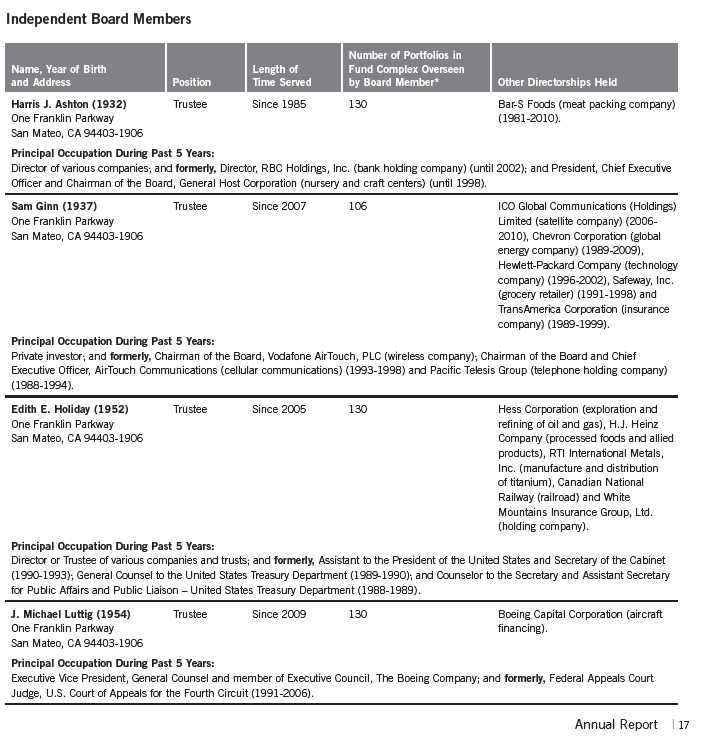
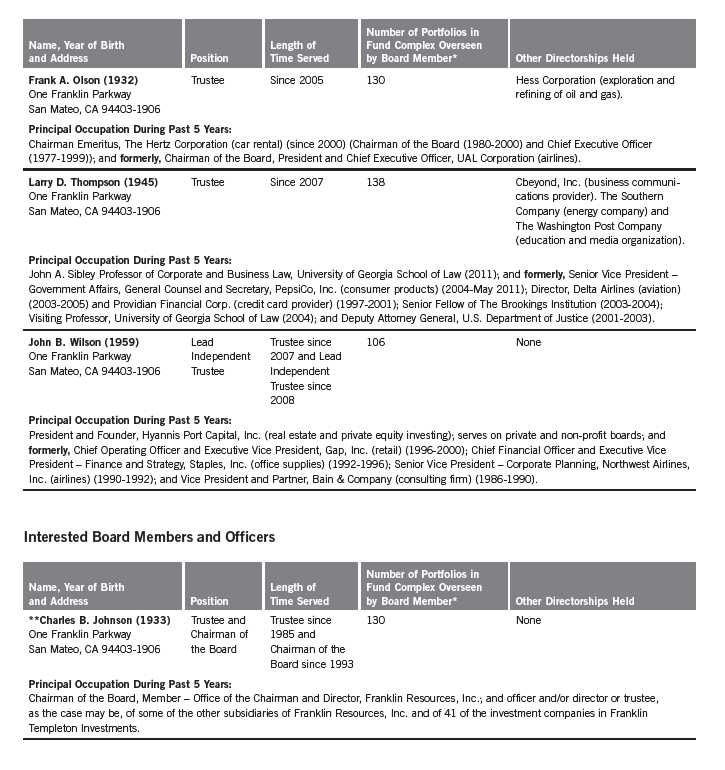
18 | Annual Report
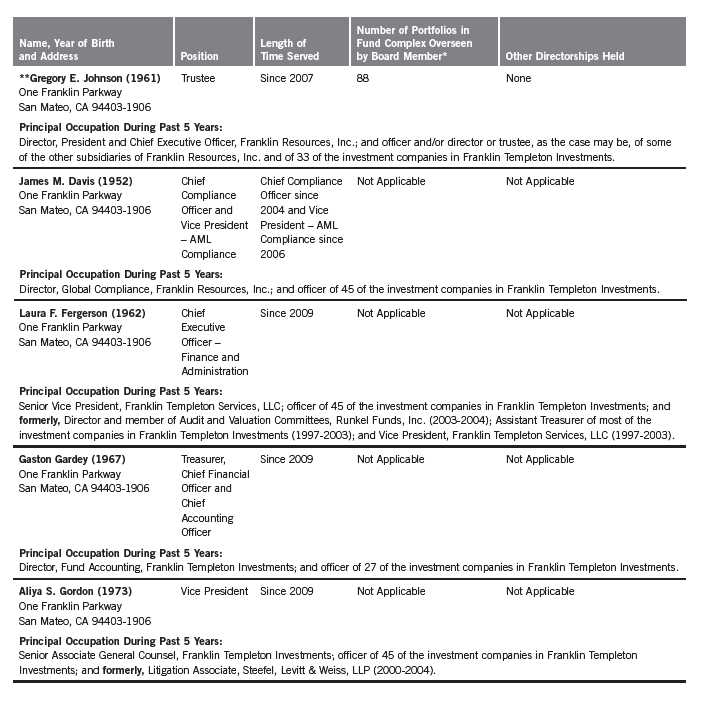
Annual Report | 19
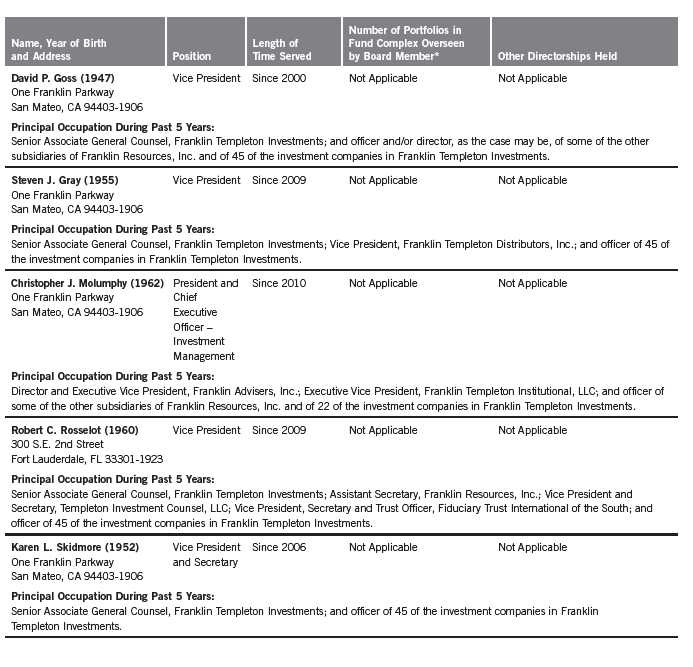


Annual Report | 21
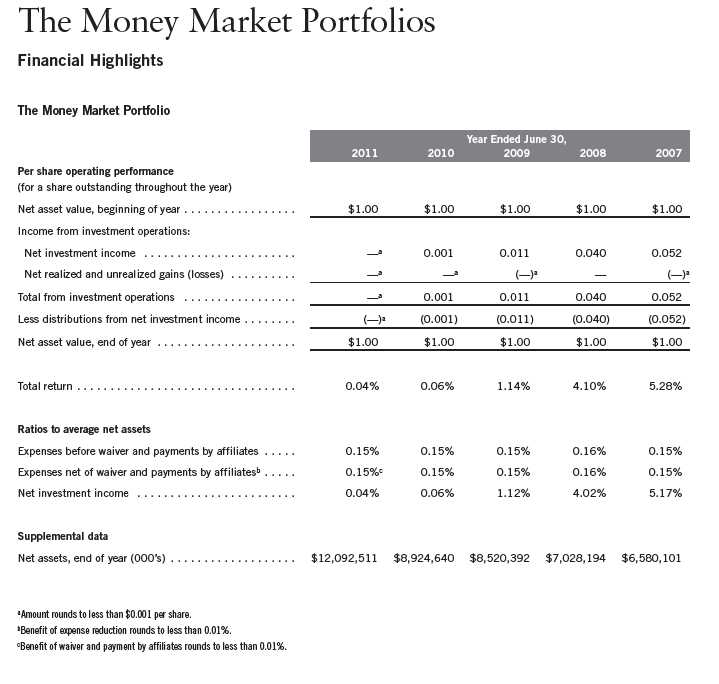
22 | The accompanying notes are an integral part of these financial statements. | Annual Report
| The Money Market Portfolios | ||||
| Statement of Investments, June 30, 2011 | ||||
| The Money Market Portfolio | Principal Amount* | Value | ||
| Investments 100.2% | ||||
| Certificates of Deposit 17.4% | ||||
| Bank of Montreal, Chicago Branch, 0.12%, 7/07/11 | $ | 175,000,000 | $ | 175,000,000 |
| Bank of Montreal, Chicago Branch, 0.13%, 7/07/11 | 125,000,000 | 125,000,000 | ||
| Bank of Montreal, Chicago Branch, 0.12%, 7/11/11 | 200,000,000 | 200,000,000 | ||
| Bank of Nova Scotia, Houston Branch, 0.11% - 0.24%, 7/05/11 - 8/24/11 | 475,000,000 | 475,000,000 | ||
| National Australia Bank, New York Branch, 0.18%, 7/18/11 | 150,000,000 | 150,000,000 | ||
| National Australia Bank, New York Branch, 0.09% - 0.16%, 7/11/11 - 9/06/11 | 350,000,000 | 350,000,000 | ||
| Royal Bank of Canada, New York Branch, 0.13%, 9/26/11 | 100,000,000 | 100,001,208 | ||
| The Toronto-Dominion Bank, New York Branch, 0.12%, 7/20/11 | 150,000,000 | 150,000,000 | ||
| The Toronto-Dominion Bank, New York Branch, 0.17% - 0.27%, 7/05/11 - 9/07/11 | 300,000,000 | 300,000,000 | ||
| Westpac Banking Corp., New York Branch, 0.25%, 7/08/11 | 75,000,000 | 75,000,000 | ||
| Total Certificates of Deposit (Cost $2,100,001,208) | 2,100,001,208 | |||
| aCommercial Paper 49.7% | ||||
| Abbott Laboratories, 7/11/11 - 7/26/11 | 306,000,000 | 305,979,631 | ||
| Australia and New Zealand Banking Group Ltd., 7/06/11 (Australia) | 200,000,000 | 199,994,306 | ||
| Australia and New Zealand Banking Group Ltd., 8/26/11 (Australia) | 100,000,000 | 99,975,111 | ||
| Australia and New Zealand Banking Group Ltd., 9/27/11 (Australia) | 200,000,000 | 199,912,000 | ||
| Bank of Nova Scotia, 8/01/11 (Canada) | 21,070,000 | 21,066,553 | ||
| Chevron Texaco Corp., 7/07/11 - 7/13/11 | 250,000,000 | 249,995,820 | ||
| Colgate-Palmolive Co., 7/14/11 - 8/01/11 | 131,500,000 | 131,494,450 | ||
| Commonwealth Bank of Australia, 7/05/11 - 11/28/11 (Australia) | 533,641,000 | 533,462,567 | ||
| Concentrate Manufacturing Co. of Ireland, 7/11/11 (Ireland) | 67,400,000 | 67,398,315 | ||
| Export Development Canada, 7/19/11 (Canada) | 50,000,000 | 49,996,250 | ||
| General Electric Co., 7/01/11 | 500,000,000 | 500,000,000 | ||
| Johnson & Johnson, 7/25/11 | 215,305,000 | 215,279,163 | ||
| Johnson & Johnson, 7/18/11 - 8/30/11 | 36,578,000 | 36,567,116 | ||
| Kingdom of Denmark, 7/27/11 (Denmark) | 100,000,000 | 99,995,306 | ||
| Nestle Capital Corp., 7/05/11 - 8/30/11 (Switzerland) | 161,925,000 | 161,910,647 | ||
| Nestle Finance International Ltd., 8/22/11 (Switzerland) | 196,800,000 | 196,765,888 | ||
| Nestle Finance International Ltd., 9/07/11 - 9/26/11 (Switzerland) | 104,000,000 | 103,975,677 | ||
| Novartis Finance Corp., 7/14/11 (Switzerland) | 20,000,000 | 19,998,303 | ||
| Novartis Finance Corp., 10/17/11 (Switzerland) | 150,000,000 | 149,892,000 | ||
| PepsiCo Inc., 7/22/11 - 9/02/11 | 375,000,000 | 374,959,460 | ||
| Pfizer Inc., 7/14/11 | 200,000,000 | 199,995,667 | ||
| Procter & Gamble International Funding, 7/08/11 | 150,000,000 | 149,997,958 | ||
| Procter & Gamble International Funding, 7/15/11 | 242,500,000 | 242,493,399 | ||
| Procter & Gamble International Funding, 7/18/11 | 100,000,000 | 99,996,222 | ||
| Province of Ontario, 7/28/11 (Canada) | 275,000,000 | 274,983,500 | ||
| Province of Ontario, 7/07/11 - 8/31/11 (Canada) | 232,375,000 | 232,351,602 | ||
| The Toronto-Dominion Bank, 7/15/11 (Canada) | 50,000,000 | 49,997,083 | ||
| United Parcel Service Inc., 7/19/11 | 175,000,000 | 174,995,625 | ||
| Wal-Mart Stores Inc., 7/08/11 | 179,080,000 | 179,077,263 | ||
| Wal-Mart Stores Inc., 7/01/11 - 7/27/11 | 242,900,000 | 242,891,753 | ||
| Westpac Banking Corp., 9/07/11 (Australia) | 150,000,000 | 149,939,083 | ||
| Westpac Banking Corp., 8/01/11 - 12/08/11 (Australia) | 298,500,000 | 298,327,190 | ||
| Total Commercial Paper (Cost $6,013,664,908) | 6,013,664,908 | |||
Annual Report | 23
The Money Market Portfolios
Statement of Investments, June 30, 2011 (continued)
| The Money Market Portfolio | Principal Amount* | Value | ||
| Investments (continued) | ||||
| U.S. Government and Agency Securities 9.4% | ||||
| a FHLB, 7/06/11 - 7/13/11 | $ | 140,000,000 | $ | 139,998,361 |
| a FHLMC, 7/06/11 | 73,800,000 | 73,799,898 | ||
| a FNMA, 7/06/11 - 7/08/11 | 118,250,000 | 118,249,087 | ||
| a,bInternational Bank for Reconstruction & Development, | ||||
| 7/27/11 (Supranational) | 151,700,000 | 151,692,606 | ||
| 8/08/11 (Supranational) | 150,000,000 | 149,990,500 | ||
| 7/05/11 - 8/22/11 (Supranational) | 247,000,000 | 246,983,013 | ||
| a U.S. Treasury Bill, | ||||
| 4/05/12 | 100,000,000 | 99,794,625 | ||
| 6/28/12 | 150,000,000 | 149,724,473 | ||
| Total U.S. Government and Agency Securities (Cost $1,130,232,563) | 1,130,232,563 | |||
| Municipal Bonds 3.6% | ||||
| c California Infrastructure and Economic Development Bank Revenue, J. Paul Getty Trust, | ||||
| Refunding, Series D, Daily VRDN and Put, 0.02%, 4/01/33 | 21,025,000 | 21,025,000 | ||
| c California State Economic Recovery GO, | ||||
| Series C-2, Daily VRDN and Put, 0.03%, 7/01/23 | 32,400,000 | 32,400,000 | ||
| Series C-4, Daily VRDN and Put, 0.03%, 7/01/23 | 35,790,000 | 35,790,000 | ||
| Durham County Industrial Facilities and PCFA Revenue, Chesterfield Project, Recovery Zone | ||||
| Facility Bonds, Mandatory Put 9/29/11, 0.40%, 1/01/41 | 22,000,000 | 22,000,000 | ||
| c Metropolitan Water District of Southern California Water Revenue, Special, Refunding, | ||||
| Series A, Weekly VRDN and Put, 0.04%, 10/01/29 | 76,030,000 | 76,030,000 | ||
| New York Liberty Development Corp. Liberty Revenue, World Trade Center, Mandatory | ||||
| Put 2/01/12, Series A-1, 0.35%, 12/01/49 | 248,000,000 | 248,000,000 | ||
| Total Municipal Bonds (Cost $435,245,000) | 435,245,000 | |||
| Total Investments before Repurchase Agreements (Cost $9,679,143,679) | 9,679,143,679 | |||
| dRepurchase Agreements 20.1% | ||||
| Barclays Capital Inc., 0.00%, 7/01/11 (Maturity Value $100,000,000) | ||||
| Collateralized by U.S. Treasury Notes, 0.625%, 1/31/13 (valued at $102,529,154) | 100,000,000 | 100,000,000 | ||
| Deutsche Bank Securities Inc., 0.00%, 7/01/11 (Maturity Value $435,980,000) | ||||
| Collateralized by U.S. Treasury Notes, 0.00% - 10.625%, 7/31/11 - 4/15/18 | ||||
| (valued at $444,699,607) | 435,980,000 | 435,980,000 | ||
| Goldman, Sachs & Co., 0.010%, 7/01/11 (Maturity Value $400,000,111) | ||||
| Collateralized by U.S. Government and Agency Securities, 0.17% - 1.125%, | ||||
| 4/02/12 - 7/30/12 (valued at $408,509,689) | 400,000,000 | 400,000,000 | ||
| HSBC Securities (USA) Inc., 0.005%, 7/01/11 (Maturity Value $325,000,045) | ||||
| Collateralized by U.S. Government and Agency Securities, 0.00% - 6.27%, | ||||
| 8/05/11 - 4/18/16 (valued at $331,503,756) | 325,000,000 | 325,000,000 | ||
| J.P. Morgan Securities LLC, 0.00%, 7/01/11 (Maturity Value $600,000,000) | ||||
| Collateralized by U.S. Government and Agency Securities, 0.00% - 6.125%, | ||||
| 7/18/11 - 5/15/16 (valued at $612,004,767) | 600,000,000 | 600,000,000 | ||
| Merrill Lynch, Pierce, Fenner & Smith Inc., 0.010%, (Maturity Value $300,000,083) | ||||
| Collateralized by U.S. Government and Agency Securities, 0.00% - 5.625%, | ||||
| 7/25/11 - 7/15/37 (valued at $306,000,349) | 300,000,000 | 300,000,000 | ||
| Morgan Stanley & Co. LLC, 0.00%, 7/01/11 (Maturity Value $125,000,000) | ||||
| Collateralized by U.S. Treasury Notes, 0.625% - 1.875%, | ||||
| 4/15/13 - 7/15/15 (valued at $127,500,080) | 125,000,000 | 125,000,000 |
24 | Annual Report
The Money Market Portfolios
Statement of Investments, June 30, 2011 (continued)
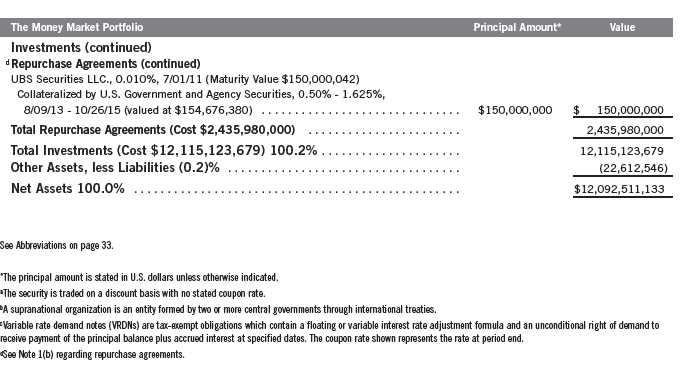
Annual Report | The accompanying notes are an integral part of these financial statements. | 25
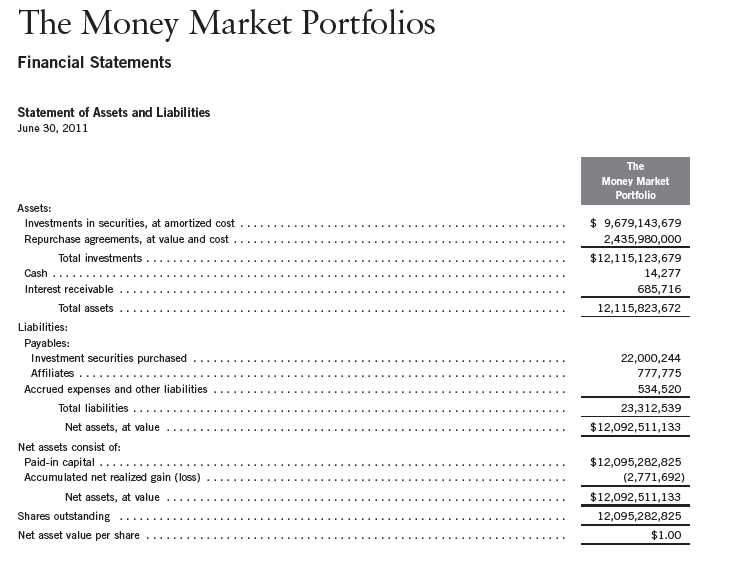
26 | The accompanying notes are an integral part of these financial statements. | Annual Report

Annual Report | The accompanying notes are an integral part of these financial statements. | 27
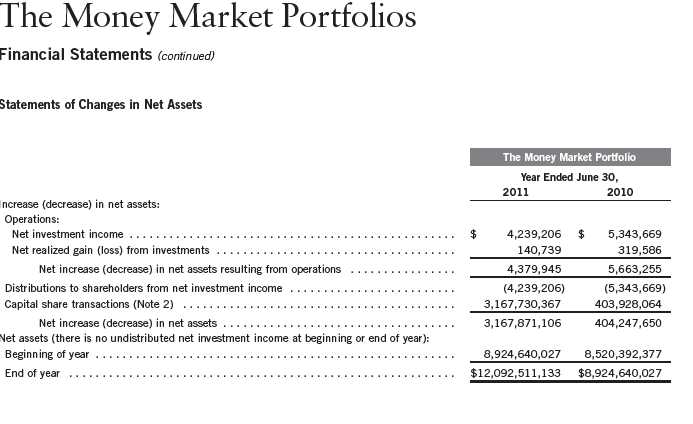
28 | The accompanying notes are an integral part of these financial statements. | Annual Report
The Money Market Portfolios
Notes to Financial Statements
The Money Market Portfolio
1. ORGANIZATION AND SIGNIFICANT ACCOUNTING POLICIES
The Money Market Portfolios (Trust) is registered under the Investment Company Act of 1940, as amended, (1940 Act) as an open-end investment company, consisting of one portfolio, The Money Market Portfolio (Portfolio). The shares of the Portfolio are issued in private placements and are exempt from registration under the Securities Act of 1933.
The following summarizes the Portfolio’s significant accounting policies.
a. Financial Instrument Valuation
Securities are valued at amortized cost, which approximates market value. Amortized cost is an income-based approach which involves valuing an instrument at its cost and thereafter assuming a constant amortization to maturity of any discount or premium.
b. Repurchase Agreements
The Portfolio enters into repurchase agreements, which are accounted for as a loan by the Portfolio to the seller, collateralized by securities which are delivered to the Portfolio’s custodian. The market value, including accrued interest, of the initial collateralization is required to be at least 102% of the dollar amount invested by the Portfolio, with the value of the underlying securities marked to market daily to maintain coverage of at least 100%. All repurchase agreements held by the Portfolio at year end had been entered into on June 30, 2011.
c. Income Taxes
It is the Portfolio’s policy to qualify as a regulated investment company under the Internal Revenue Code. The Portfolio intends to distribute to shareholders substantially all of its taxable income and net realized gains to relieve it from federal income and excise taxes. As a result, no provision for U.S. federal income taxes is required. The Portfolio files U.S. income tax returns as well as tax returns in certain other jurisdictions. The Portfolio records a provision for taxes in its financial statements including penalties and interest, if any, for a tax position taken on a tax return (or expected to be taken) when it fails to meet the more likely than not (a greater than 50% probability) threshold and based on the technical merits, the tax position may not be sustained upon examination by the tax authorities. As of June 30, 2011, and for all open tax years, the Portfolio has determined that no provision for income tax is required in the Portfolio’s financial statements. Open tax years are those that remain subject to examination and are based on each tax jurisdiction statute of limitation.
d. Security Transactions, Investment Income, Expenses and Distributions
Security transactions are accounted for on trade date. Realized gains and losses on security transactions are determined on a specific identification basis. Interest income and estimated expenses are accrued daily. Amortization of premium and accretion of discount on debt securities are
Annual Report | 29
The Money Market Portfolios
Notes to Financial Statements (continued)
The Money Market Portfolio
| 1. | ORGANIZATION AND SIGNIFICANT ACCOUNTING POLICIES (continued) |
| d. | Security Transactions, Investment Income, Expenses and Distributions (continued) |
included in interest income. Dividends from net investment income are normally declared daily; these dividends may be reinvested or paid monthly to shareholders. Distributions to shareholders are determined according to income tax regulations (tax basis). Distributable earnings determined on a tax basis may differ from earnings recorded in accordance with accounting principles generally accepted in the United States of America. These differences may be permanent or temporary. Permanent differences are reclassified among capital accounts to reflect their tax character. These reclassifications have no impact on net assets or the results of operations. Temporary differences are not reclassified, as they may reverse in subsequent periods.
e. Accounting Estimates
The preparation of financial statements in accordance with accounting principles generally accepted in the United States of America requires management to make estimates and assumptions that affect the reported amounts of assets and liabilities at the date of the financial statements and the amounts of income and expenses during the reporting period. Actual results could differ from those estimates.
f. Guarantees and Indemnifications
Under the Trust’s organizational documents, its officers and trustees are indemnified by the Trust against certain liabilities arising out of the performance of their duties to the Trust. Additionally, in the normal course of business, the Trust, on behalf of the Portfolio, enters into contracts with service providers that contain general indemnification clauses. The Trust’s maximum exposure under these arrangements is unknown as this would involve future claims that may be made against the Trust that have not yet occurred. Currently, the Trust expects the risk of loss to be remote.
2. SHARES OF BENEFICIAL INTEREST
At June 30, 2011, there were an unlimited number of shares authorized (without par value).
Transactions in the Portfolio’s shares at $1.00 per share were as follows:

30 | Annual Report
The Money Market Portfolios
Notes to Financial Statements (continued)
The Money Market Portfolio
3. TRANSACTIONS WITH AFFILIATES
Franklin Resources, Inc. is the holding company for various subsidiaries that together are referred to as Franklin Templeton Investments. Certain officers and trustees of the Trust are also officers, directors, and/or trustees of the Franklin Money Fund, the Franklin Templeton Money Fund Trust, the Institutional Fiduciary Trust, and of the following subsidiaries:
| Subsidiary | Affiliation |
| Franklin Advisers, Inc. (Advisers) | Investment manager |
| Franklin Templeton Investor Services, LLC (Investor Services) | Transfer agent |
a. Management Fees
The Portfolio pays an investment management fee to Advisers of 0.15% per year of the average daily net assets of the Portfolio.
b. Transfer Agent Fees
Investor Services, under terms of an agreement, performs shareholder servicing for the Portfolio and is not paid by the Portfolio for the services.
c. Waiver and Expense Reimbursements
In efforts to prevent a negative yield, Advisers has voluntarily agreed to waive or limit its fees, assume as its own expense certain expenses otherwise payable by the Portfolio and if necessary, make a capital infusion into the Portfolio. These waivers, expense reimbursements and capital infusions are voluntary and may be modified or discontinued by Advisers at any time, and without further notice. There is no guarantee that the Portfolio will be able to avoid a negative yield.
d. Other Affiliated Transactions
At June 30, 2011, the shares of the Portfolio were owned by the following entities:

4. EXPENSE OFFSET ARRANGEMENT
The Portfolio has entered into an arrangement with its custodian whereby credits realized as a result of uninvested cash balances are used to reduce a portion of the Portfolio’s custodian expenses. During the year ended June 30, 2011, the custodian fees were reduced as noted in the Statement of Operations.
Annual Report | 31
The Money Market Portfolios
Notes to Financial Statements (continued)
The Money Market Portfolio
5. INCOME TAXES
For tax purposes, capital losses may be carried over to offset future capital gains, if any. At June 30, 2011, the Portfolio had tax basis capital losses of $2,771,692 expiring in 2017. During the year ended June 30, 2011 the Portfolio utilized $140,739 of capital loss carryforwards.
Under the Regulated Investment Company Modernization Act of 2010, the Portfolio will be permitted to carry forward capital losses incurred in taxable years beginning after December 22, 2010 for an unlimited period. Post-enactment capital loss carryforwards will retain their character as either short-term or long-term capital losses rather than being considered short-term as under previous law. Any post-enactment capital losses generated in the future will be required to be utilized prior to the losses incurred in pre-enactment tax years.
The tax character of distributions paid during the years ended June 30, 2011 and 2010, was as follows:

At June 30, 2011, the cost of investments and undistributed ordinary income for income tax purposes were as follows:

6. FAIR VALUE MEASUREMENTS
The Portfolio follows a fair value hierarchy that distinguishes between market data obtained from independent sources (observable inputs) and the Portfolio’s own market assumptions (unobservable inputs). These inputs are used in determining the value of the Portfolio’s investments and are summarized in the following fair value hierarchy:
- Level 1 – quoted prices in active markets for identical securities
- Level 2 – other significant observable inputs (including quoted prices for similar securities, interest rates, prepayment speed, credit risk, etc.)
- Level 3 – significant unobservable inputs (including the Portfolio’s own assumptions in determining the fair value of investments)
The inputs or methodology used for valuing securities are not an indication of the risk associated with investing in those securities. Money market securities may be valued using amortized cost, in accordance with the 1940 Act. Generally, amortized cost reflects the current fair value of a
32 | Annual Report
The Money Market Portfolios
Notes to Financial Statements (continued)
The Money Market Portfolio
6. FAIR VALUE MEASUREMENTS (continued)
security, but since the value is not obtained from a quoted price in an active market, such securities are reflected as a Level 2.
For movements between the levels within the fair value hierarchy, the Portfolio has adopted a policy of recognizing the transfers as of the date of the underlying event which caused the movement.
At June 30, 2011, all of the Portfolio’s investments in securities carried at fair value were in Level 2 inputs.
7. NEW ACCOUNTING PRONOUNCEMENTS
In May 2011, the Financial Accounting Standards Board (FASB) issued Accounting Standards Update (ASU) No. 2011-04, Fair Value Measurement (Topic 820): Amendments to Achieve Common Fair Value Measurement and Disclosure Requirements in U.S. GAAP and International Financial Reporting Standards (IFRS). The amendments in the ASU will improve the comparability of fair value measurements presented and disclosed in financial statements prepared in accordance with U.S. GAAP and IFRS and include new guidance for certain fair value measurement principles and disclosure requirements. The ASU is effective for interim and annual periods beginning after December 15, 2011. The Portfolio is currently evaluating the impact, if any, of applying this provision.
8. SUBSEQUENT EVENTS
The Portfolio has evaluated subsequent events through the issuance of the financial statements and determined that no events have occurred that require disclosure.
ABBREVIATIONS
Selected Portfolio
| FHLB | - | Federal Home Loan Bank |
| FHLMC | - | Federal Home Loan Mortgage Corp. |
| FNMA | - | Federal National Mortgage Association |
| GO | - General Obligation | |
| PCFA | - | Pollution Control Financing Authority |
Annual Report | 33
The Money Market Portfolios
Report of Independent Registered Public Accounting Firm
To the Board of Trustees and Shareholders of The Money Market Portfolio
In our opinion, the accompanying statement of assets and liabilities, including the statement of investments, and the related statements of operations and of changes in net assets and the financial highlights present fairly, in all material respects, the financial position of The Money Market Portfolio (the “Fund”) at June 30, 2011, the results of its operations for the year then ended, the changes in its net assets for each of the two years in the period then ended and the financial highlights for each of the five years in the period then ended, in conformity with accounting principles generally accepted in the United States of America. These financial statements and financial highlights (hereafter referred to as “financial statements”) are the responsibility of the Fund’s management. Our responsibility is to express an opinion on these financial statements based on our audits. We conducted our audits of these financial statements in accordance with the standards of the Public Company Accounting Oversight Board (United States). Those standards require that we plan and perform the audit to obtain reasonable assurance about whether the financial statements are free of material misstatement. An audit includes examining, on a test basis, evidence supporting the amounts and disclosures in the financial statements, assessing the accounting principles used and significant estimates made by management, and evaluating the overall financial statement presentation. We believe that our audits, which included confirmation of securities at June 30, 2011 by correspondence with the custodian and brokers, provide a reasonable basis for our opinion.
PricewaterhouseCoopers LLP
San Francisco, California
August 18, 2011
34 | Annual Report
The Money Market Portfolios
Tax Designation (unaudited)
The Money Market Portfolio
Under Section 871(k)(1)(C) of the Internal Revenue Code (Code), the Fund designates the maximum amount allowable but no less than $2,235,433 as interest related dividends for purposes of the tax imposed under Section 871(a)(1)(A) of the Code for the fiscal year ended June 30, 2011.
Annual Report | 35
The Money Market Portfolios
Board Members and Officers
The name, year of birth and address of the officers and board members, as well as their affiliations, positions held with the Trust, principal occupations during the past five years and number of portfolios overseen in the Franklin Templeton Investments fund complex are shown below. Generally, each board member serves until that person’s successor is elected and qualified.
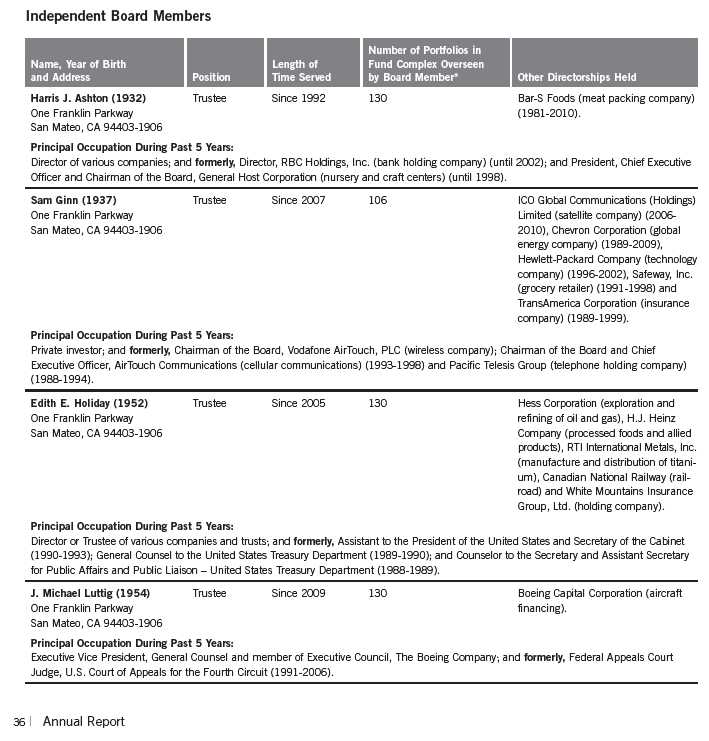
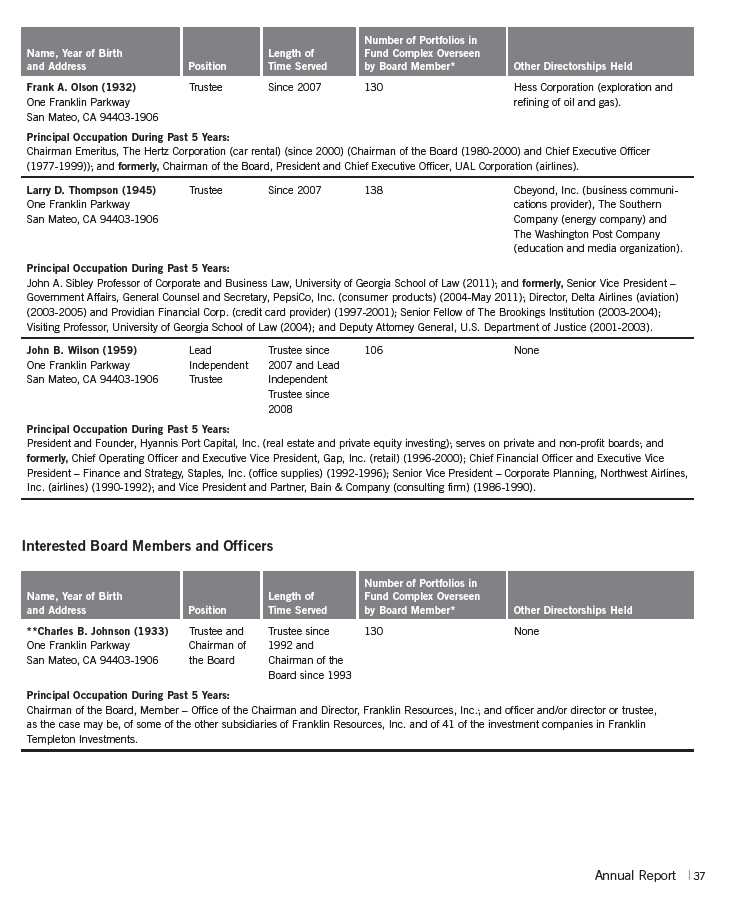
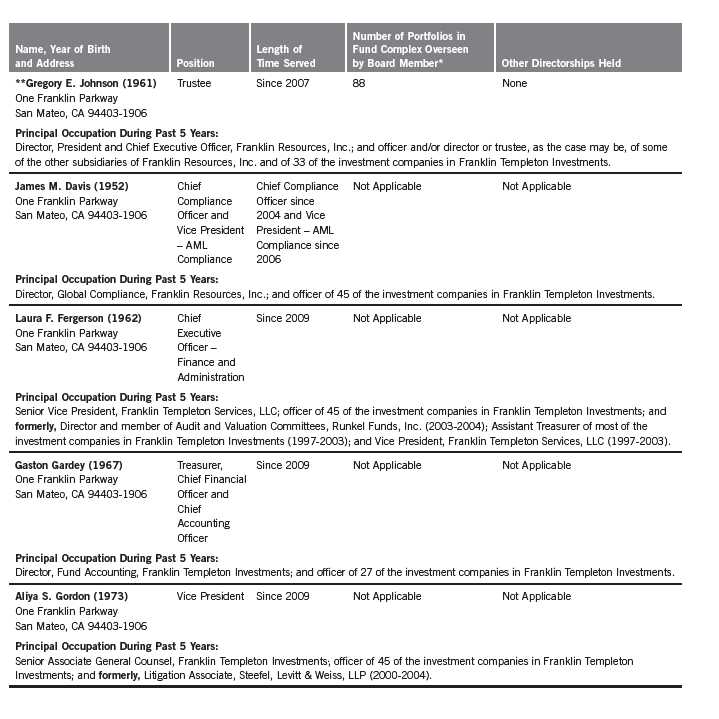

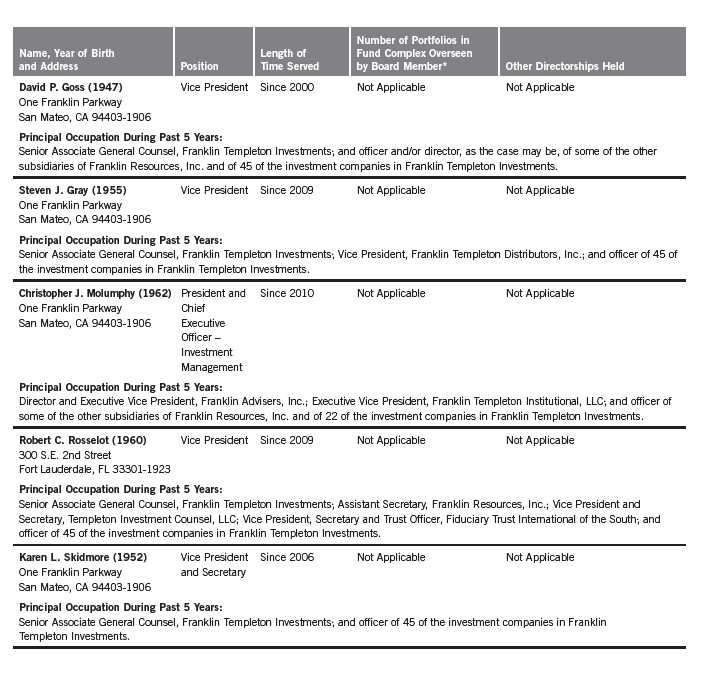
Annual Report | 39
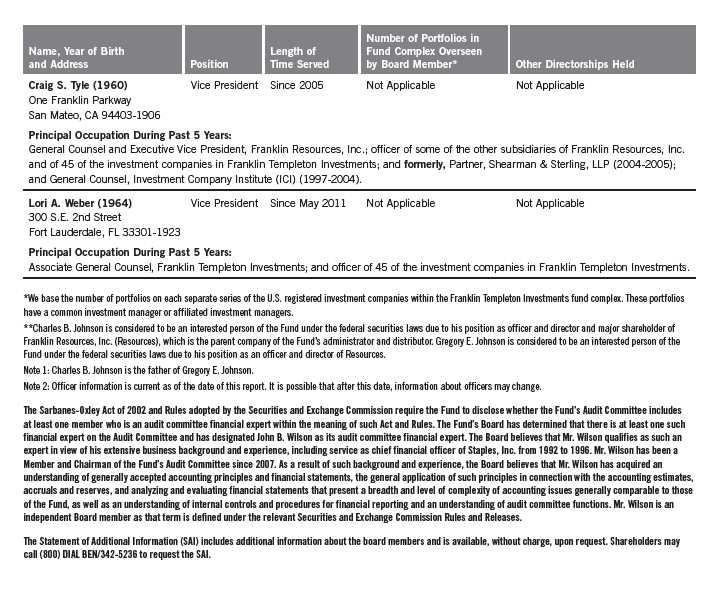
40 | Annual Report
Institutional Fiduciary Trust
Shareholder Information
IFT Money Market Portfolio
Board Review of Investment Management Agreement
At a meeting held April 19, 2011, the Board of Trustees (Board), including a majority of non-interested or independent Trustees, approved renewal of the investment management agreement for the Trust’s Money Market Portfolio (Fund). In reaching this decision, the Board took into account information furnished throughout the year at regular Board meetings, as well as information prepared specifically in connection with the annual renewal review process. Information furnished and discussed throughout the year included investment performance reports and related financial information for the Fund, as well as periodic reports on expenses, shareholder services, legal, compliance, pricing, brokerage commissions and execution and other services provided by the Investment Manager (Manager) and its affiliates. Information furnished specifically in connection with the renewal process included a report for the Fund prepared by Lipper, Inc. (Lipper), an independent organization, as well as additional material, including a Fund profitability analysis prepared by management. The Lipper reports compared the Fund’s investment performance and expenses with those of other mutual funds deemed comparable to the Fund as selected by Lipper. The Fund profitability analysis discussed the profitability to Franklin Templeton Investments from its overall U.S. fund operations, as well as on an individual fund-by-fund basis. Additional material accompanying such profitability analysis included information on a fund-by-fund basis listing portfolio managers and other accounts they manage, as well as information on management fees charged by the Manager and its affiliates to U.S. mutual funds and other accounts, including management’s explanation of differences where relevant. Such material also included a memorandum prepared by management describing project initiatives and capital investments relating to the services provided to the Fund by the Franklin Templeton Investments organization, as well as a memorandum relating to economies of scale and a comparative analysis concerning transfer agent fees charged the Fund.
In considering such materials, the independent Trustees received assistance and advice from and met separately with independent counsel. In approving continuance of the investment management agreement for the Fund, the Board, including a majority of independent Trustees, determined that the existing management fee structure was fair and reasonable and that continuance of the investment management agreement was in the best interests of the Fund and its shareholders. While attention was given to all information furnished, the following discusses some primary factors relevant to the Board’s decision.
NATURE, EXTENT AND QUALITY OF SERVICE. The Board was satisfied with the nature and quality of the overall services provided by the Manager and its affiliates to the Fund and its shareholders. In addition to investment performance and expenses discussed later, the Board’s opinion was based, in part, upon periodic reports furnished it showing that the investment policies and restrictions for the Fund were consistently complied with as well as other reports periodically furnished the Board covering matters such as the compliance of portfolio managers and other management personnel with the code of ethics adopted throughout the Franklin Templeton fund complex, the adherence to fair value pricing procedures established by the Board, and the accuracy
Annual Report | 41
Institutional Fiduciary Trust
Shareholder Information (continued)
IFT Money Market Portfolio
Board Review of Investment Management Agreement (continued)
of net asset value calculations. The Board also noted the extent of benefits provided Fund shareholders from being part of the Franklin Templeton family of funds, including the right to exchange investments between the same class of funds without a sales charge, the ability to reinvest Fund dividends into other funds and the right to combine holdings in other funds to obtain a reduced sales charge. Favorable consideration was given to management’s continuous efforts and expenditures in establishing back-up systems and recovery procedures to function in the event of a natural disaster, it being noted that such systems and procedures had functioned smoothly during the Florida hurricanes and blackouts experienced in previous years. Among other factors taken into account by the Board were the Manager’s best execution trading policies, including a favorable report by an independent portfolio trading analytical firm. Consideration was also given to the experience of the Fund’s portfolio management team, the number of accounts managed and general method of compensation. In this latter respect, the Board noted that a primary factor in management’s determination of a portfolio manager’s bonus compensation was the relative investment performance of the funds he or she managed and that a portion of such bonus was required to be invested in a predesignated list of funds within such person’s fund management area so as to be aligned with the interests of shareholders. The Board also took into account the quality of transfer agent and shareholder services provided Fund shareholders by an affiliate of the Manager and the continuous enhancements to the Franklin Templeton website. Particular attention was given to management’s conservative approach and diligent risk management procedures, including continuous monitoring of counterparty credit risk and attention given to derivatives and other complex instruments. The Board also took into account, among other things, management’s efforts in establishing a global credit facility for the benefit of the Fund and other accounts managed by Franklin Templeton Investments to provide a source of cash for temporary and emergency purposes or to meet unusual redemption requests as well as the strong financial position of the Manager’s parent company and its commitment to the mutual fund business as evidenced by its subsidization of the Fund and other money market funds.
INVESTMENT PERFORMANCE. The Board placed significant emphasis on the investment performance of the Fund in view of its importance to shareholders. While consideration was given to performance reports and discussions with portfolio managers at Board meetings throughout the year, particular attention in assessing performance was given to the Lipper reports furnished for the agreement renewal. The Lipper reports prepared for the Fund showed its investment performance for the one-year period ended January 31, 2011, as well as the previous 10 years ended that date in comparison to a performance universe consisting of the Fund and all institutional money market funds as selected by Lipper. The Lipper report comparison showed the Fund’s total return to be in the second-lowest quintile of such universe for the one-year period, and on an annualized basis to be in either the lowest or second-lowest quintile of such universe for each of the previous three-, five- and 10-year periods. In discussing such performance, management pointed out that it reflected the Fund’s conservative strategy of investing only in securities having the highest short-term
42 | Annual Report
Institutional Fiduciary Trust
Shareholder Information (continued)
IFT Money Market Portfolio
Board Review of Investment Management Agreement (continued)
ratings from all rating agencies that rate such securities, which strategy resulted in lower yields. The Board found such performance to be acceptable in light of such explanation, noting also that the Fund’s expenses were subsidized by management to avoid net asset value falling below one dollar per share and that the median return within the Lipper universe for the one-year period was three basis points.
COMPARATIVE EXPENSES. Consideration was given to a comparative analysis of the management fees and total expense ratio of the Fund compared with those of a group of other funds selected by Lipper as its appropriate Lipper expense group. Lipper expense data is based upon information taken from each fund’s most recent annual report, which reflects historical asset levels that may be quite different from those currently existing, particularly in a period of market volatility. While recognizing such inherent limitation and the fact that expense ratios generally increase as assets decline and decrease as assets grow, the Board believed the independent analysis conducted by Lipper to be an appropriate measure of comparative expenses. In reviewing comparative costs, Lipper provides information on the Fund’s contractual investment management fees in comparison with the contractual investment management fee that would have been charged by other funds within its Lipper expense group assuming they were similar in size to the master money market fund through which the Fund invests, as well as the actual total expenses of the Fund in comparison with those of its Lipper expense group. The Lipper contractual investment management fee analysis includes administrative charges as being part of a management fee. The Lipper report showed the Fund’s contractual investment management fee rate to be in the most expensive quintile of its Lipper expense group, while its total expense ratio was less than six basis points higher than the median of such group. In discussing these expenses, management pointed out to the Board that this Fund is not actively marketed and largely serves as an alternative and frequently temporary investment vehicle for institutional investors and other funds within the Franklin/Templeton/Mutual Series fund families and provides same day wiring and exchange privileges for its shareholders. Management also pointed out that the Fund’s expenses were subsidized through fee waivers. The Board found such comparative expenses to be acceptable, noting the points raised by management.
MANAGEMENT PROFITABILITY. The Board also considered the level of profits realized by the Manager and its affiliates in connection with the operation of the Fund. In this respect, the Board reviewed the Fund profitability analysis that addresses the overall profitability of Franklin Templeton’s U.S. fund business, as well as its profits in providing management and other services to the Fund during the 12-month period ended September 30, 2010, being the most recent fiscal year-end for Franklin Resources, Inc., the Manager’s parent. In reviewing the analysis, attention was given to the methodology followed in allocating costs to the Fund, it being recognized that allocation methodologies are inherently subjective and various allocation methodologies may each be reasonable while producing different results. In this respect, the Board noted that, while being
Annual Report | 43
Institutional Fiduciary Trust
Shareholder Information (continued)
IFT Money Market Portfolio
Board Review of Investment Management Agreement (continued)
continuously refined and reflecting changes in the Manager’s own cost accounting, the allocation methodology was consistent with that followed in profitability report presentations for the Fund made in prior years and that the Fund’s independent registered public accounting firm had been engaged by the Manager to review the reasonableness of the allocation methodologies solely for use by the Fund’s Board in reference to the profitability analysis. In reviewing and discussing such analysis, management discussed with the Board its belief that costs incurred in establishing the infrastructure necessary for the type of mutual fund operations conducted by the Manager and its affiliates may not be fully reflected in the expenses allocated to the Fund in determining its profitability, as well as the fact that the level of profits, to a certain extent, reflected operational cost savings and efficiencies initiated by management. The Board also took into account management’s expenditures in improving shareholder services provided the Fund, as well as the need to meet additional regulatory and compliance requirements resulting from the Sarbanes-Oxley Act and recent SEC and other regulatory requirements. In addition, the Board considered a third-party study comparing the profitability of the Manager’s parent on an overall basis to other publicly held managers broken down to show profitability from management operations exclusive of distribution expenses, as well as profitability including distribution expenses. The Board also considered the extent to which the Manager and its affiliates might derive ancillary benefits from fund operations, including revenues generated from transfer agent services. Based upon its consideration of all these factors, the Board determined that the level of profits realized by the Manager and its affiliates from providing services to the Fund was not excessive in view of the nature, quality and extent of services provided.
ECONOMIES OF SCALE. The Board also considered whether economies of scale are realized by the Manager as the Fund grows larger and the extent to which this is reflected in the level of management fees charged. While recognizing that any precise determination is inherently subjective, the Board noted that based upon the Fund profitability analysis, it appears that as some funds get larger, at some point economies of scale do result in the Manager realizing a larger profit margin on management services provided such a fund. The Fund is part of a master- feeder relationship and the advisory fee at the master fund level is a flat 0.15% at all asset levels. In addition, the Fund charges a separate administrative fee amount of 0.20% at all asset levels. In discussing such fees, management pointed out that a significant portion of the Fund’s assets at any given time consisted of investments by other funds within the Franklin Templeton complex pursuant to cash sweep arrangements aimed at efficient management of their excess cash. It was further noted that shareholders of funds participating in such arrangements benefited from the fact that their fund’s normally higher advisory and administrative fees were reduced to the levels charged the Fund on assets invested under such cash sweep arrangements. While the Fund’s net assets at December 31, 2010, were approximately $10.25 billion, the Board believed it problematic in view of the nature and role served by this Fund within the Franklin Templeton complex, the services it provides, and the subsidization of its expenses through fee waivers that the Manager and its affiliates benefited from any meaningful economies of scale.
44 | Annual Report
Institutional Fiduciary Trust
Shareholder Information (continued)
IFT Money Market Portfolio
Proxy Voting Policies and Procedures
The Trust’s investment manager has established Proxy Voting Policies and Procedures (Policies) that the Trust uses to determine how to vote proxies relating to portfolio securities. Shareholders may view the Trust’s complete Policies online at franklintempleton.com. Alternatively, shareholders may request copies of the Policies free of charge by calling the Proxy Group collect at (954) 527-7678 or by sending a written request to: Franklin Templeton Companies, LLC, 300 S.E. 2nd Street, Fort Lauderdale, FL 33301, Attention: Proxy Group. Copies of the Trust’s proxy voting records are also made available online at franklintempleton.com and posted on the U.S. Securities and Exchange Commission’s website at sec.gov and reflect the most recent 12-month period ended June 30.
Quarterly Statement of Investments
The Trust files a complete statement of investments with the U.S. Securities and Exchange Commission for the first and third quarters for each fiscal year on Form N-Q. Shareholders may view the filed Form N-Q by visiting the Commission’s website at sec.gov. The filed form may also be viewed and copied at the Commission’s Public Reference Room in Washington, DC. Information regarding the operations of the Public Reference Room may be obtained by calling (800) SEC-0330.
Householding of Reports and Prospectuses
You will receive the Fund’s financial reports every six months as well as an annual updated summary prospectus (prospectus available upon request). To reduce Fund expenses, we try to identify related shareholders in a household and send only one copy of the financial reports and summary prospectus. This process, called “householding,” will continue indefinitely unless you instruct us otherwise. If you prefer not to have these documents householded, please call us at (800) 632-2301. At any time you may view current prospectuses/summary prospectuses and financial reports on our website. If you choose, you may receive these documents through electronic delivery.
Annual Report | 45
This page intentionally left blank.
This page intentionally left blank.
This page intentionally left blank.
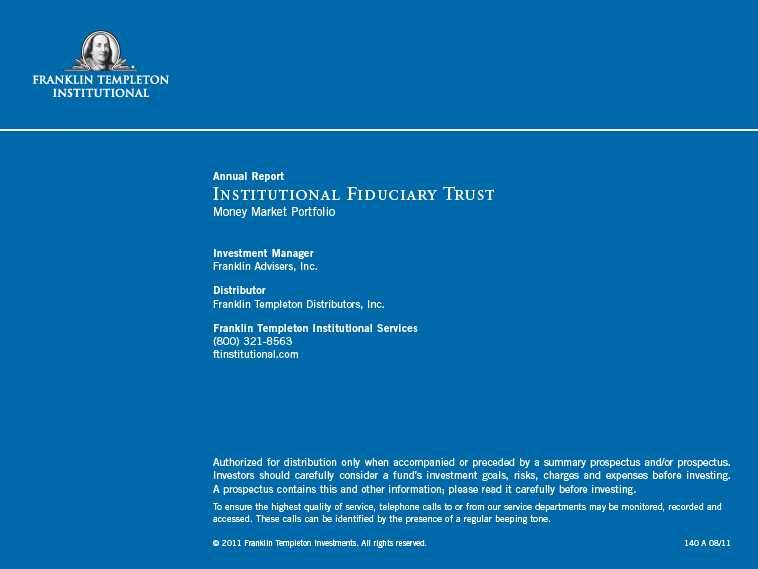
Item 2. Code of Ethics.
(a) The Registrant has adopted a code of ethics that applies to its principal executive officers and principal financial and accounting officer.
(c) N/A
(d) N/A
(f) Pursuant to Item 12(a)(1), the Registrant is attaching as an exhibit a copy of its code of ethics that applies to its principal executive officers and principal financial and accounting officer.
Item 3. Audit Committee Financial Expert.
(a)(1) The Registrant has an audit committee financial expert serving on its audit committee.
(2) The audit committee financial expert is John B. Wilson and he is "independent" as defined under the relevant Securities and Exchange Commission Rules and Releases.
Item 4. Principal Accountant Fees and Services.
(a) Audit Fees
The aggregate fees paid to the principal accountant for professional services rendered by the principal accountant for the audit of the registrant’s annual financial statements or for services that are normally provided by the principal accountant in connection with statutory and regulatory filings or engagements were $57,664 for the fiscal year ended June 30, 2011 and $54,523 for the fiscal year ended June 30, 2010.
(b) Audit-Related Fees
There were no fees paid to the principal accountant for assurance and related services rendered by the principal accountant to the registrant that are reasonably related to the performance of the audit of the registrant's financial statements and are not reported under paragraph (a) of Item 4.
There were no fees paid to the principal accountant for assurance and related services rendered by the principal accountant to the registrant's investment adviser and any entity controlling, controlled by or under common control with the investment adviser that provides ongoing services to the registrant that are reasonably related to the performance of the audit of their financial statements.
(c) Tax Fees
There were no fees paid to the principal accountant for professional services rendered by the principal accountant to the registrant for tax compliance, tax advice and tax planning.
The aggregate fees paid to the principal accountant for professional services rendered by the principal accountant to the registrant’s investment adviser and any entity controlling, controlled by or under common control with the investment adviser that provides ongoing services to the registrant for tax compliance, tax advice and tax planning were $85,000 for the fiscal year ended June 30, 2011 and $0 for the fiscal year ended June 30, 2010. The services for which these fees were paid included technical tax consultation for capital gain tax reporting to foreign governments and the application of the local country tax laws to investments made by various Franklin Templeton funds.
(d) All Other Fees
The aggregate fees paid to the principal accountant for products and services rendered by the principal accountant to the registrant not reported in paragraphs (a)-(c) of Item 4 were $3,275 for the fiscal year ended June 30, 2011 and $0 for the fiscal year ended June 30, 2010. The services for which these fees were paid included review of materials provided to the fund Board in connection with the investment management contract renewal process.
The aggregate fees paid to the principal accountant for products and services rendered by the principal accountant to the registrant’s investment adviser and any entity controlling, controlled by or under common control with the investment adviser that provides ongoing services to the registrant other than services reported in paragraphs (a)-(c) of Item 4 were $141,525 for the fiscal year ended June 30, 2011 and $0 for the fiscal year ended June 30, 2010. The services for which these fees were paid included review of materials provided to the fund Board in connection with the investment management contract renewal process.
(e) (1) The registrant’s audit committee is directly responsible for approving the services to be provided by the auditors, including:
(i) pre-approval of all audit and audit related services;
(ii) pre-approval of all non-audit related services to be provided to the Fund by the auditors;
(iii) pre-approval of all non-audit related services to be provided to the registrant by the auditors to the registrant’s investment adviser or to any entity that controls, is controlled by or is under common control with the registrant’s investment adviser and that provides ongoing services to the registrant where the non-audit services relate directly to the operations or financial reporting of the registrant; and
(iv) establishment by the audit committee, if deemed necessary or appropriate, as an alternative to committee pre-approval of services to be provided by the auditors, as required by paragraphs (ii) and (iii) above, of policies and procedures to permit such services to be pre-approved by other means, such as through establishment of guidelines or by action of a designated member or members of the committee; provided the policies and procedures are detailed as to the particular service and the committee is informed of each service and such policies and procedures do not include delegation of audit
committee responsibilities, as contemplated under the Securities Exchange Act of 1934, to management; subject, in the case of (ii) through (iv), to any waivers, exceptions or exemptions that may be available under applicable law or rules.
(e) (2) None of the services provided to the registrant described in paragraphs (b)-(d) of Item 4 were approved by the audit committee pursuant to paragraph (c)(7)(i)(C) of Rule 2-01 of regulation S-X.
(f) No disclosures are required by this Item 4(f).
(g) The aggregate non-audit fees paid to the principal accountant for services rendered by the principal accountant to the registrant and the registrant’s investment adviser and any entity controlling, controlled by or under common control with the investment adviser that provides ongoing services to the registrant were $229,800 for the fiscal year ended June 30, 2011 and $0 for the fiscal year ended June 30, 2010.
(h) The registrant’s audit committee of the board has considered whether the provision of non-audit services that were rendered to the registrant’s investment adviser (not including any sub-adviser whose role is primarily portfolio management and is subcontracted with or overseen by another investment adviser), and any entity controlling, controlled by, or under common control with the investment adviser that provides ongoing services to the registrant that were not pre-approved pursuant to paragraph (c)(7)(ii) of Rule 2-01 of Regulation S-X is compatible with maintaining the principal accountant’s independence.
Item 5. Audit Committee of Listed Registrants. N/A
Item 6. Schedule of Investments. N/A
Item 7. Disclosure of Proxy Voting Policies and Procedures for Closed-End Management Investment Companies. N/A
Item 8. Portfolio Managers of Closed-End Management Investment Companies. N/A
Item 9. Purchases of Equity Securities by Closed-End Management Investment Company and Affiliated Purchasers. N/A
Item 10. Submission of Matters to a Vote of Security Holders.
There have been no changes to the procedures by which shareholders may recommend nominees to the Registrant's Board of Trustees that would require disclosure herein.
Item 11. Controls and Procedures.
(a) Evaluation of Disclosure Controls and Procedures. The Registrant maintains disclosure controls and procedures that are designed to ensure that information required to be disclosed in the Registrant’s filings under the Securities Exchange Act of 1934 and the Investment Company Act of 1940 is recorded, processed, summarized and reported within the periods specified in the rules and forms of the Securities and Exchange Commission. Such information is accumulated and communicated to the Registrant’s management, including its principal executive officer and principal financial officer, as appropriate, to allow timely decisions regarding required disclosure. The Registrant’s management, including the principal executive officer and the principal financial officer, recognizes that any set of controls and procedures, no matter how well designed and operated, can provide only reasonable assurance of achieving the desired control objectives.
Within 90 days prior to the filing date of this Shareholder Report on Form N-CSR, the Registrant had carried out an evaluation, under the supervision and with the participation of the Registrant’s management, including the Registrant’s principal executive officer and the Registrant’s principal financial officer, of the effectiveness of the design and operation of the Registrant’s disclosure controls and procedures. Based on such evaluation, the Registrant’s principal executive officer and principal financial officer concluded that the Registrant’s disclosure controls and procedures are effective.
(b) Changes in Internal Controls. There have been no significant changes in the Registrant’s internal controls or in other factors that could significantly affect the internal controls subsequent to the date of their evaluation in connection with the preparation of this Shareholder Report on Form N-CSR.
Item 12. Exhibits.
(a)(1) Code of Ethics
(a)(2) Certifications pursuant to Section 302 of the Sarbanes-Oxley Act of 2002 of Laura F. Fergerson, Chief Executive Officer - Finance and Administration, and Gaston Gardey, Chief Financial Officer and Chief Accounting Officer
(b) Certifications pursuant to Section 906 of the Sarbanes-Oxley Act of 2002 of Laura F. Fergerson, Chief Executive Officer - Finance and Administration, and Gaston Gardey, Chief Financial Officer and Chief Accounting Officer
SIGNATURES
Pursuant to the requirements of the Securities Exchange Act of 1934 and the Investment Company Act of 1940, the registrant has duly caused this report to be signed on its behalf by the undersigned, thereunto duly authorized.
INSTITUTIONAL FIDUCIARY TRUST
By /s/LAURA F. FERGERSON
Laura F. Fergerson
Chief Executive Officer - Finance and Administration
Date August 25, 2011
Pursuant to the requirements of the Securities Exchange Act of 1934 and
the Investment Company Act of 1940, this report has been signed below
by the following persons on behalf of the registrant and in the
capacities and on the dates indicated.
By /s/LAURA F. FERGERSON
Laura F. Fergerson
Chief Executive Officer - Finance and Administration
Date August 25, 2011
By /s/GASTON GARDEY
Gaston Gardey
Chief Financial Officer and Chief Accounting Officer
Date August 25, 2011